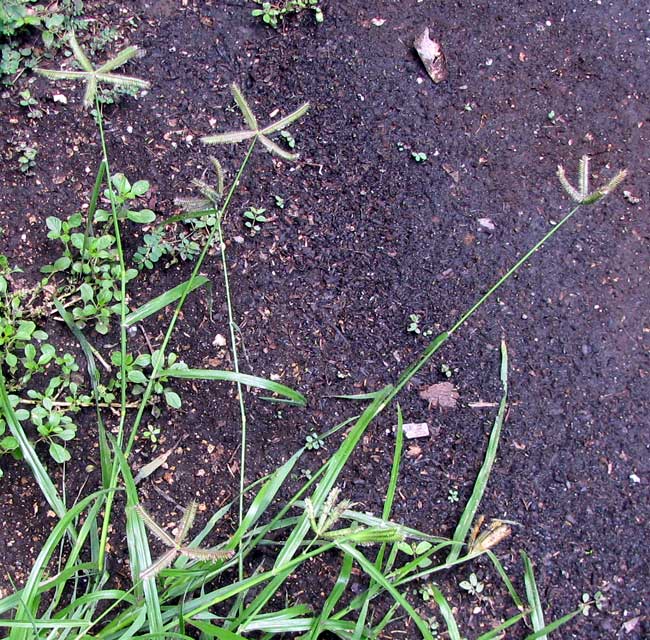Excerpts from Jim Conrad's
Naturalist Newsletter

from the August 22, 2010 Newsletter issued from Hacienda Chichen Resort beside Chichén Itzá Ruins, central Yucatán, MÉXICO; limestone bedrock, elevation ~39m (~128ft), ~N20.676°, ~W88.569°
CROWFOOT GRASS
Lately we've looked at several grasses with flowering heads, or inflorescences, composed of several slender, spike-like racemes arising from atop a stiff flowerhead stem, or rachis. In the North the best-known grasses with that inflorescence construction are the crabgrasses and Bermuda Grass. There's a yard-wide (1 m), sprawling, foot-high patch of grass in front of my hut like that and it's none we've considered so far. You can see its blades and starfish-shaped heads above.
A closer look at one of its nicely symmetrical heads is below:

In that picture, notice how the tips of the flowerhead branch stems, the rachillas, pass a little beyond the flowers below them, ending in a sharp point. This feature helped me come up with the grass's identity, revealed below.
At first I thought the grass was a stubby form of Bermuda Grass, but then I examined the flower structure, shown in a raceme cross-section, below:

In the picture, spikelets are arranged along one side, the lower, of the rachilla, in two rows, and the spikelets alternately angle off right or left. Bermuda Grass's spikelets bear only one floret, while you can see that each of this species' spikelets have three or four. If you need to be refreshed on the relationship between spikelets and their florets, check out www.backyardnature.net/gr_flort.jpg.
This turns out to be Egyptian Crowfoot Grass, DACTYLOCTENIUM AEGYPTIUM, an African native but now occurring as a weed throughout the world's warmer areas, even deep into the US. It's easy to identify because of its star-shaped heads with much shorter and stiffer arms than crabgrass or Bermuda Grass, plus the before-mentioned sharp rachilla tips extending beyond the flowers.
In most of the world Egyptian Crowfoot Grass is just a weed, but in Africa it's valued as a famine food. If a lot of mature plants are growing together and dropping their sandgrain-size fruits, enough grains can be collected to provide some nutritious nibbling.